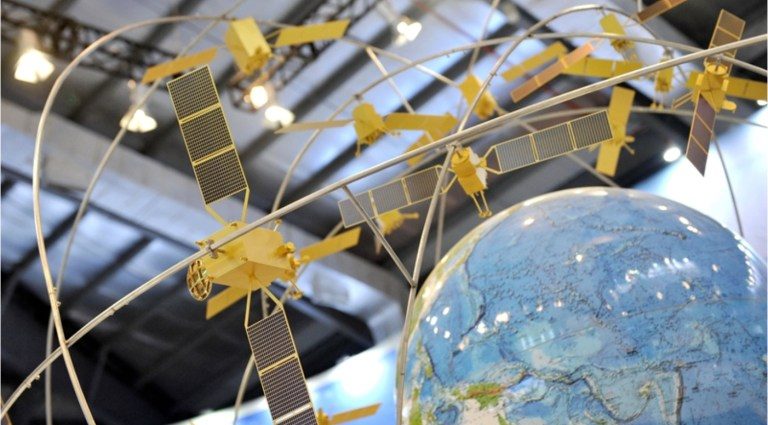China is seeking to promote the civil use of its satellite navigation system with the launch of a new chip that can support short messages on smartphones in remote areas.
The built-in chip would allow smartphone users to send and receive short messages through the country’s BeiDou navigation satellite system, Yang Changfeng, chief architect of the system and an academician of the Chinese Academy of Engineering, told media in a recent interview.
Yang said China would optimize the use of its satellites and telecommunication facilities to improve the performance of BeiDou, which is now accurate to within one meter.
Chen Zhonggui, chief designer of the BeiDou-3 satellite, said 45 BeiDou satellites were now in operation. Chen said the system was accurate to within three to five meters globally and within one to three meters in the Asia-Pacific region.
On Wednesday, China North Industries Corporation, China Mobile, China Electronics Technology Group Corp and local mobile phone makers jointly launched a chip that can allow mobile phone users to send and receive short messages through BeiDou.
BeiDou’s Yang said this new feature could help protect people in wild areas and deep-sea fishery workers. Yang said more and more applications would be introduced to consumers while driverless vehicles would use BeiDou in the future.

A 22-nanometer BeiDou high-precision positioning chip was launched in September 2020 and has been mass-produced since last year. The chip, which is small enough to be built into smartphones, can also receive signals from the US’ GPS, Russia’s Glonass and the European Union’s Galileo systems.
On August 3, the China Satellite Navigation Office unveiled 35 licenses that allow the commercial use of BeiDou’s Radionavigation Satellite Service (RNSS).
In May, the office said in a white paper that China’s satellite navigation industry’s revenues grew 16.3% to 469 billion yuan (US$69.5 billion) last year from 2020. It said the government wanted to monetize BeiDou and use the income to support the system’s further development.
The office said BeiDou could be used in areas such as telecommunication, power allocation, disaster work, public safety, transport, agriculture and aquaculture, hydrological monitoring and meteorological observation, as well as long-range military strikes.
It said the system could be applied together with the Internet of Things, artificial intelligence and big data technologies.
Beijing became aware of the importance of building its own satellite navigation system after it saw that the United States army greatly increased the accuracy of its weapons with the US’ Global Positioning System (GPS) during the Gulf War in 1991. China started building its own in 1994.
In 1995, then-Taiwanese president Lee Teng-hui delivered a speech about Taiwan’s democratization experience at Cornell University in the US. He was criticized by Beijing for trying to separate Taiwan from China. To retaliate, the People’s Liberation Army (PLA) launched four ballistic missiles at Taiwan’s waters in July 1995 and one more in March 1996.
Chinese state media later admitted that only the first missile had hit the target but the following ones missed their marks. They said that the US may have turned off the GPS that China was using at the time. The incident prompted China to accelerate the development of its satellite navigation system, namely BeiDou, which means the Big Dipper, the reports said.
On July 31, 2020, Chinese President Xi Jinping announced that the third generation BeiDou system’s set-up had been completed. On July 31 this year, the China Aerospace Science and Technology Corp (CASC), a state-owned enterprise, announced the official launch of BeiDou’s global satellite navigation services.
It is still unclear if the PLA used the BeiDou system when it launched 11 Dongfeng ballistic missiles into Taiwan’s waters on Thursday in response to US House of Representatives Speaker Nancy Pelosi’s visit to the self-governing island.

Over the past few years, Chinese media have reported about BeiDou’s military applications.
In a 2018 report, the PLA used a BeiDou smartwatch, which can track the locations and health conditions of its soldiers and allow them to call for help and report live situations. To hide their location, soldiers can destroy the watch by pushing a one-touch button, the report said.
Another article said BeiDou could be used to guide the LeiShi-6 (LS-6) Thunder Stone glide bomb, which does not require expensive sensors and cameras.
Citing Russia’s military operations in Ukraine this year, the article said the Russian army wasted a large number of missiles as it did not have a high-precision satellite navigation system to guide them.
It said BeiDou could still be used as a supplementary tool to guide China’s intercontinental ballistic missiles, such as the Dongfeng-41, although their ultra-high speed might lower the navigation system’s accuracy.
Zhu Jiangming, a military columnist, wrote in an article published by the Southern People Weekly that some ballistic missiles including the Dongfeng-21 had to reduce their speed to below 10 times the speed of sound in order to be guided by BeiDou.
Read: China steals space race march with lab module launch
Follow Jeff Pao on Twitter at @jeffpao3

